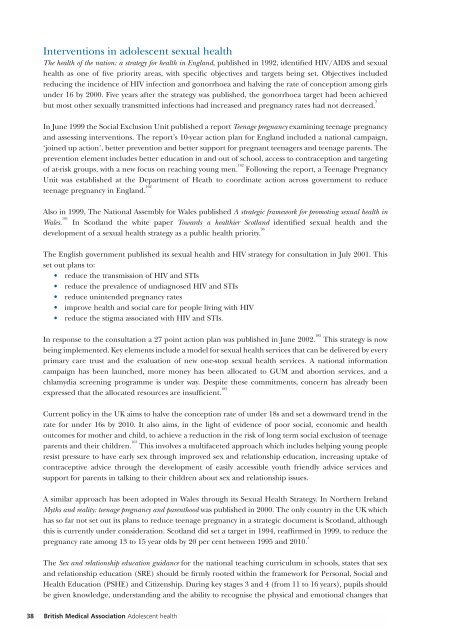Alcohol misuse: tackling the UK epidemic - London
Alcohol misuse: tackling the UK epidemic - London
Alcohol misuse: tackling the UK epidemic - London
Create successful ePaper yourself
Turn your PDF publications into a flip-book with our unique Google optimized e-Paper software.
38<br />
Interventions in adolescent sexual health<br />
The health of <strong>the</strong> nation: a strategy for health in England, published in 1992, identified HIV/AIDS and sexual<br />
health as one of five priority areas, with specific objectives and targets being set. Objectives included<br />
reducing <strong>the</strong> incidence of HIV infection and gonorrhoea and halving <strong>the</strong> rate of conception among girls<br />
under 16 by 2000. Five years after <strong>the</strong> strategy was published, <strong>the</strong> gonorrhoea target had been achieved<br />
but most o<strong>the</strong>r sexually transmitted infections had increased and pregnancy rates had not decreased. 3<br />
In June 1999 <strong>the</strong> Social Exclusion Unit published a report Teenage pregnancy examining teenage pregnancy<br />
and assessing interventions. The report’s 10-year action plan for England included a national campaign,<br />
‘joined up action’, better prevention and better support for pregnant teenagers and teenage parents. The<br />
prevention element includes better education in and out of school, access to contraception and targeting<br />
of at-risk groups, with a new focus on reaching young men. 162<br />
Following <strong>the</strong> report, a Teenage Pregnancy<br />
Unit was established at <strong>the</strong> Department of Heath to coordinate action across government to reduce<br />
teenage pregnancy in England. 162<br />
Also in 1999, The National Assembly for Wales published A strategic framework for promoting sexual health in<br />
Wales. 181<br />
In Scotland <strong>the</strong> white paper Towards a healthier Scotland identified sexual health and <strong>the</strong><br />
development of a sexual health strategy as a public health priority. 96<br />
The English government published its sexual health and HIV strategy for consultation in July 2001. This<br />
set out plans to:<br />
• reduce <strong>the</strong> transmission of HIV and STIs<br />
• reduce <strong>the</strong> prevalence of undiagnosed HIV and STIs<br />
• reduce unintended pregnancy rates<br />
• improve health and social care for people living with HIV<br />
• reduce <strong>the</strong> stigma associated with HIV and STIs.<br />
In response to <strong>the</strong> consultation a 27 point action plan was published in June 2002. 182<br />
This strategy is now<br />
being implemented. Key elements include a model for sexual health services that can be delivered by every<br />
primary care trust and <strong>the</strong> evaluation of new one-stop sexual health services. A national information<br />
campaign has been launched, more money has been allocated to GUM and abortion services, and a<br />
chlamydia screening programme is under way. Despite <strong>the</strong>se commitments, concern has already been<br />
expressed that <strong>the</strong> allocated resources are insufficient. 183<br />
Current policy in <strong>the</strong> <strong>UK</strong> aims to halve <strong>the</strong> conception rate of under 18s and set a downward trend in <strong>the</strong><br />
rate for under 16s by 2010. It also aims, in <strong>the</strong> light of evidence of poor social, economic and health<br />
outcomes for mo<strong>the</strong>r and child, to achieve a reduction in <strong>the</strong> risk of long term social exclusion of teenage<br />
parents and <strong>the</strong>ir children. 163<br />
This involves a multifaceted approach which includes helping young people<br />
resist pressure to have early sex through improved sex and relationship education, increasing uptake of<br />
contraceptive advice through <strong>the</strong> development of easily accessible youth friendly advice services and<br />
support for parents in talking to <strong>the</strong>ir children about sex and relationship issues.<br />
A similar approach has been adopted in Wales through its Sexual Health Strategy. In Nor<strong>the</strong>rn Ireland<br />
Myths and reality: teenage pregnancy and parenthood was published in 2000. The only country in <strong>the</strong> <strong>UK</strong> which<br />
has so far not set out its plans to reduce teenage pregnancy in a strategic document is Scotland, although<br />
this is currently under consideration. Scotland did set a target in 1994, reaffirmed in 1999, to reduce <strong>the</strong><br />
pregnancy rate among 13 to 15 year olds by 20 per cent between 1995 and 2010. 4<br />
The Sex and relationship education guidance for <strong>the</strong> national teaching curriculum in schools, states that sex<br />
and relationship education (SRE) should be firmly rooted within <strong>the</strong> framework for Personal, Social and<br />
Health Education (PSHE) and Citizenship. During key stages 3 and 4 (from 11 to 16 years), pupils should<br />
be given knowledge, understanding and <strong>the</strong> ability to recognise <strong>the</strong> physical and emotional changes that<br />
British Medical Association Adolescent health
















